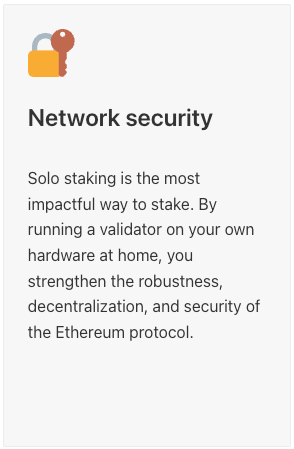Sept. 8, 2022: Mis-Stakes, I've Made a Few
Misadventures in Solo Staking on Ropsten, Sepolia, Görli and Mainnet
Should you run a solo staking node in the run-up to the merge?
From a technical perspective, yes, absolutely! There’s no better way to make sure Ethereum stays decentralized in the run-up to the merge:
Running a solo staking node is not for everybody though. First off, you need 32 ETH to do so. Luckily ETH has gone on sale — it would have cost ~$150K to procure the deposit at ATH, but blessedly is down to ~$50K. Still, it remains a hefty price tag for a community still coping about the loss of most of their net worth on paper.
More importantly though, it can be technically daunting. A lot of guides like to flex that you can be up and running with $CHAD minutes of work, (where $CHAD is substituted with some absurdly low number like 15).
While that may be true once you are experienced in the process, attaining the level of experience to feel comfortable could take several weeks. Documentation is often missing or wrong. Written tutorials don’t work out quite as easily. Success criteria are sometimes non-obvious. You may think everything is perfect, only to find out you missed something after you passed the point of no return. The checklist is a mile long!


It’s a modestly high-stakes game as well. If your node is configured incorrectly, you will lose money — not huge amounts, but enough to provide a disincentive. It’s not always obvious if your node is configured correctly. You may find yourself in a situation where you need to squash some esoteric bug, with the added pressure that every minute you can’t solve the problem your net worth will evaporate slightly.
Moreover, you need to commit to guaranteeing uptime for the next year or so until the Shanghai update. Pity the Europoor who started staking in peacetime, only to find only a greater duke could afford the electricity to run basic appliances. Or what of the unfortunate Californian suffering an electric grid spottier than post-invasion Baghdad? Such stress!
We’re more technically savvy than the majority of the population, yet it was still a difficult path. At multiple stages of the process we nearly gave up and threw our device out the window. We experienced three ETH testnet merges, all of which were complete failures. In total it took 5 months of hobbyist hours to go from the start of the process to seeing the first .00001 ETH accrue from successfully validating a block.
If you are interested in solo staking and have questions, you are invited to DM. A second set of eyes could be useful. Here are some of the resources we found helpful:
0xTexasHedge thread to get us started
Someresat has incredibly detailed resources for nearly any execution/consensus client pairing
The Ethereum website has good guides and lists of resources
Coincashew’s guide had a comprehensive and useful guide.
All the various documentation was useful, and we’d ultimately try out Geth, Besu, Nethermind, and Prism throughout the journey, but we found Nimbus documentation worked well throughout
For most people though, we’d simply recommend you ping the great team at Rocket Pool. When we hit absolute rock bottom, the team helpfully reached out and offered help with elementary debugging, even though we weren’t using their service. What an outstanding commitment to ensuring a great Ethereum merge!
What follows the paywall are notes from the perilous journey. If you’re looking for a guide, we recommend the above resources instead. We do not intend to provide an exhaustive set of instructions. Everything to follow is more narrative than technical. It’s a story of one fool’s hardship and suffering that may make your life feel better by comparison.






